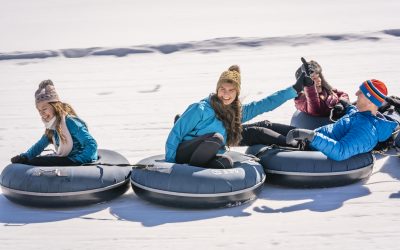“This is an opportunity in a very iconic destination to reimagine some parts of our visitor experience. And the opportunity hopefully only ever presents itself once in a lifetime.” – Tyler Riopel
What if a crisis could become the catalyst for building a better tourism destination? For Tourism Jasper, that’s exactly what’s happening after the historic 2024 wildfire that affected over 32,000 hectares in Jasper National Park and damaged one-third of the townsite.
Tyler Riopel, CEO of Tourism Jasper, reveals how this iconic Rocky Mountain destination is transforming crisis into opportunity. Home to the world’s second-largest dark sky preserve and welcoming 2.4 million visitors annually, Jasper faced a monumental challenge when wildfires struck during peak tourism season, forcing the evacuation of 25,000 people.
Rather than simply seeking to rebuild what was lost, Tyler explains how Tourism Jasper is reimagining its future—addressing chronic issues like workforce housing, seasonality challenges, and climate adaptation, while maintaining the community’s character. Though still recovering, the Park is open to visitors, and Tyler emphasizes that economic stability through tourism is essential for social and community healing.
While 97% of Jasper National Park remained unimpacted by the wildfire, the experience has created unique opportunities for visitor education about wildfire ecology, forest regeneration, and climate change impacts. New offerings include wildfire ecology tours that showcase natural renewal processes across different time periods.
Tyler’s insights reveal the delicate balance destinations must strike during recovery—welcoming visitors respectfully while communities heal, staying transparent about current conditions, and leveraging tourism as a force for long-term community resilience. His message is clear: this once-in-a-lifetime rebuilding opportunity could position Jasper as an even stronger, more sustainable destination for future generations.
On Travel Beyond, you’ll learn:
- How Jasper’s unique position as the world’s largest accessible dark sky preserve creates extraordinary stargazing opportunities and shapes everything from street lighting to annual festivals.
- About Jasper’s innovative approach to wildfire recovery tourism, including educational ecology tours that show forest regeneration across different time periods, rather than hiding fire impacts from visitors.
- How Tourism Jasper is leveraging the rebuilding process to address chronic mountain destination challenges like workforce housing shortages and seasonality issues.
- About Jasper’s commitment to responsible tourism messaging – encouraging visitors to come for the right reasons while respecting the ongoing recovery process and community needs.
Subscribe to Travel Beyond through Apple Podcasts, Spotify, or your favourite podcast player.
See also: Lessons in tourism recovery and crisis management from Jasper’s 2024 wildfires
Show notes
Jasper Dark Sky Preserve — Learn about the world’s second-largest dark sky preserve and discover stargazing opportunities, photography workshops, and the annual Dark Sky Festival in this remarkable mountain setting.
Jasper Planetarium — Experience guided tours in the world’s largest accessible dark sky preserve with the largest telescopes in the Canadian Rockies, offering astronomy education and stargazing experiences.
Jasper Wildfire Information — Current visitor guidelines for responsible tourism during recovery, including respectful photography practices and supporting local businesses affected by the 2024 wildfire.
Tourism Jasper — The official destination marketing organization for Jasper National Park, offering comprehensive visitor information, trip planning resources, and updates on current conditions following wildfire recovery.
Images provided by Tourism Jasper.
Episode transcript
Tyler Riopel: Five years from now, I think in a lot of aspects, we have a bit of a new Jasper, a future state for Jasper that’s better than the day before the fire. This is an opportunity in a very iconic destination to reimagine some parts of our visitor experience, and the opportunity hopefully only ever presents itself once in a lifetime.
Peter McCully: Welcome to Travel Beyond. I’m Peter McCully for Destination Think. On this episode, we look at travel’s role in making a better world, and we highlight leading destinations and change makers. Our guests are taking local action that the world can learn from. They’re helping to regenerate ecosystems, communities, and economies, and they’re often making positive change happen from the bottom up.
Many of the voices we’ve highlighted are part of the Destination Think collective, a peer group of more than 20 ambitious forward-thinking destinations, working toward a better future for travel and the planet. On today’s show, we’re exploring how destinations facing crisis can find opportunities to build back better, balancing immediate community recovery with long-term resilience.
Jasper National Park is open for visitation, but Jasper is also in the midst of post-disaster tourism recovery after the historic 2024 wildfire that affected over 32,000 hectares and damaged one third of the townsite. This iconic Rocky Mountain destination seeks to do more than rebuild what was lost.
It’s re-imagining its future. Home to the world’s second largest dark sky preserve and welcoming 2.4 million visitors annually, Jasper faces the unique challenge of balancing respectful visitor experiences with authentic community healing. Tyler Riopel, CEO of Tourism Jasper, is working through challenges that are common to many mountain destinations.
Workforce housing shortages and seasonality issues are two examples, and they’ve taken on a new urgency. The organization’s approach to recovery emphasizes that economic stability through tourism is essential for social and community healing. The visitor experience is adapting too, with the creation of wildfire ecology tours that showcase natural renewal processes and climate education.
We had the opportunity to speak with Tyler about how destinations can leverage once-in-a-lifetime rebuilding opportunities to emerge stronger and more sustainable than ever before.
Tyler Riopel: My name is Tyler Riopel. I’m the CEO of Tourism Jasper here in Jasper, Alberta. Tourism Jasper is the destination marketing organization responsible for promoting Jasper National Park and the townsite of Jasper to global audiences and attracting visitors to further our visitor economy and sustain our community.
Peter McCully: Tyler, where exactly is Jasper located and what makes it unique within Canada’s national park system?
Tyler Riopel: Jasper is the second largest dark sky preserve in the world. We’re actually the largest dark sky preserve with a major settlement inside of it, which means we are the largest accessible dark sky preserve in the world.
We’re about 350 kilometres from both Edmonton and Calgary, about a four-hour drive in the heart of Alberta’s Canadian Rockies. Jasper’s also the second largest national park in Canada, over 11,000 square kilometers within the park boundary. We’re a community of about 5,000 people that welcome an average of about 2.4 million visitors a year, which also makes us the second busiest national park in Canada, second only to Banff.
Peter McCully: What’s one thing you always take friends to do when they visit you in Jasper?
Tyler Riopel: In the summer, white water rafting, paddleboarding, swimming. I’m one of those people that subscribes to the notion of wherever you are, if given the chance, you always jump in the lake.
Jasper’s got over 1,700 lakes in the park, and only about a hundred of them are actually named, but I could list a dozen of them within a bike ride or a quick walk of the townsite, which would be the most beautiful water you’d ever get access to in your life. If it’s winter, Marmot Basin. My family is made up of a bunch of avid downhill skiers and we’re lucky to have a world-class resort in Marmot Basin, 20 minutes from town.
It has the highest base elevation of any major Canadian resort in Canada at 1,700 meters, five mountain faces, 80 marked runs. It’s an incredible place to be able to hang out in the winter for sure.
Peter McCully: It certainly sounds like it. Tyler, for travellers who prioritize sustainability and environmental responsibility, what draws them to visit you in Jasper?
Tyler Riopel: Jasper creates a really unique opportunity as all national parks do to access space and access experience. Jasper’s long been an iconic destination on the Canadian landscape. We have endless wildlife viewing opportunities. We have over a thousand kilometers of trails for people to explore. Then there’s also something that is really unique to Jasper National Park, and that is access to glaciers.
The Athabasca Glacier is probably our best known one. You can get up there, you can do tours. There are opportunities to do some citizen science things up there to help measure the impacts of climate change. It just creates really interesting opportunities for people to get into an environment that otherwise would be very difficult to get to and understand.
Peter McCully: If you could have anyone in the world visit you in Jasper, who would it be and what would you show them? Where would you take them?
Tyler Riopel: That’s a great question. Maybe somebody like David Attenborough, when you think about an iconic voice that describes place, describes experience and the natural world. I can picture him talking about our landscapes, our wildlife, our community, and even the process of recovery and resilience, the way he talks about natural processes and resilience that occurs in nature. Then probably, as the father of two female ski racers, I’d love to bring in some of those Canadian iconic ski racers, the female ski racers—Valérie Grenier, two-time Canadian Olympian, maybe Mikaela Shiffrin or Lindsey Vonn—come in and explore this jewel that we have in Marmot Basin, inspire young athletes, especially females, to continue in their sports. That’d be pretty cool.
Peter McCully: Great answer, Tyler. As you mentioned, Jasper is home to the dark sky preserve. For those who are unfamiliar, what exactly is a dark sky preserve and how does that designation shape the visitor experience in Jasper?
Tyler Riopel: Yes, Jasper’s home to the world’s second largest dark sky preserve, the world’s largest accessible dark sky preserve, meaning that we have a townsite within the preserve. That actually shapes everything in terms of when we look at infrastructure development, street lights pointing down instead of up, how we look at light pollution in our community, in our developments.
We have an annual dark sky festival every October, which is really showcasing the night sky and giving people an opportunity to learn about it and immerse themselves in it. What I would say overall, though, is that when we look at unique products in Jasper and we look at differentiating factors, we really lean into leveraging the dark sky.
Things like having a world-class planetarium so that visitors can understand and learn about it and just creating opportunities so that people can really see the night sky for what it is in an incredibly dark and pristine environment.
Peter McCully: It must offer some very interesting opportunities for those interested in astronomy, Indigenous star knowledge, et cetera.
Tyler Riopel: Yes, absolutely. The planetarium gives a really good opportunity for people to learn about astronomy and the scientific ends of stuff. But then we also look at, we’ve got some local Indigenous knowledge keepers that have programs created around the Indigenous perspective on the night sky and some of the learnings and some of the understandings from that cultural perspective.
I think about Warrior Women, run by Patricia Bauer. She runs fireside chats on a weekly basis. In the summer, of course it’s a little bit harder due to our latitude to see the night sky until quite late in the evening, but Patricia will still talk about that and use that in her storytelling because it really is unique to place for Jasper.
Peter McCully: Tyler, Jasper sits on the traditional lands of multiple Indigenous nations. How can visitors respectfully learn about and engage with Indigenous culture and knowledge during their stay there?
Tyler Riopel: First off, I’ll say that Jasper’s had a very long and storied past as it relates to Indigenous peoples and culture. I’d say that there’s still quite a bit of work to be done in that field, especially along the lines of reconciliation. That said, I just mentioned Patricia Bauer and Warrior Women. There are a couple of Indigenous-led businesses in our community that are helping us down that path, and they’re really sharing learnings and the knowledge from Indigenous cultures that lay claim to Jasper and Jasper National Park. Parks Canada opened up an Indigenous exhibit right in the middle of our townsite that really represents a great start towards educating and understanding around the various communities that have a connection to Jasper and their stories. This really hopefully creates a lot more momentum so that we continue to evolve some of those opportunities for people in the future.
Peter McCully: From a visitor’s perspective, Tyler, what makes Jasper unique compared to other Rocky Mountain destinations?
Tyler Riopel: I’d say size and authenticity. Authenticity is an often-used word, but when we look at Jasper, you really feel the sense of community and the connectedness that many other international destinations can’t really offer. We’re a small community in a very large park, so there are lots of places for people to spread out quickly. But then we also have these incredible visitor experience offerings and supporting infrastructure to ensure that the 2 million plus visitors that come to Jasper every year are able to experience and appreciate Jasper and Jasper National Park for what it is.
What you’ll see is that the community members are the ones that own the businesses. The community members are the ones that run the experiences, and there’s still space for everybody here. Summers are our busy peak season. There are lots of opportunities in the shoulders and the winters as well for people to enjoy.
Peter McCully: Off the top, we mentioned the 2024 wildfire in Jasper. What would you like people, potential visitors, to know about the wildfire and how it affects Jasper residents today?
Tyler Riopel: Thank you for asking. It’s obviously an important conversation happening right now in Jasper. The big message on this, I think, is to really understand that the spectrum of impact on residents was very broad. As a result, where individuals and where residents are at along their own personal recovery journey is also very broad. The notion of recovery from a major event is very personal. You can’t really prescribe that for anybody.
What I’ll say is two thirds of our townsite was unimpacted by the wildfires, and the large majority of that was visitor-facing infrastructure. The large majority of our visitor-facing infrastructure remains intact. We’ve been warmly welcoming visitors back, and the natural beauty of the place and of Jasper National Park remains. Ninety-seven per cent of Jasper National Park was unimpacted by the wildfire.
Unfortunately, where the fire was did have an impact on our community, primarily in the residential areas. But the overarching message is that we are a tourist destination. Without visitors, we don’t have economic recovery. Without economic recovery, we don’t have social and community recovery or stability. Visitors coming here need to understand that it is appropriate to come, that there are lots of things to do, and residents are very much warmly welcoming and encouraging visitation into Jasper.
Peter McCully: Are there ways travellers can show extra care or awareness during their visit given the wildfire?
Tyler Riopel: Yes, absolutely. As I mentioned before, that spectrum of recovery is broad. When we talk about how to visit here, we really talk about notions of responsible tourism. Some of the most important things to understand is that we’re asking people to respect closures both in and around the park, but also in our community.
Those closures are there for a reason. Some of them are safety-related, some of them are recovery-related. But we ask that people respect them, and we know that curiosity is a natural human thing. Parks Canada has done some great work to ensure access to some fire-impacted story or forest so that people can get in there and understand that. I think that’s really important, but this is a lived experience for our residents. Many of them are still living, and we are all living through recovery. Come to Jasper for the right reasons.
Take pictures of the things you would’ve always taken in Jasper—the natural beauty, the mountains, the lakes, the trails—and use it as an opportunity to educate yourself while you’re here. Find an opportunity to learn about natural processes. Find an opportunity to learn a little bit more about the impacts of climate change, because we certainly need those advocates if we’re going to start moving the needle on some of the larger challenges around this.
Peter McCully: Tyler, are there opportunities for visitors to learn more about wildfire ecology, forest regeneration, climate adaptation during their visit?
Tyler Riopel: Yes, absolutely. There are opportunities to get into that. Parks Canada, understanding that natural curiosity exists and that people are going to want to go see a fire-impacted forest, really prioritized opening up a few trails in those areas and even putting up signage and opportunities for people to engage to ensure that we can satiate that curiosity and drive that understanding. That also ensures that people aren’t necessarily going into closed areas, which by and large would still be closed because of safety considerations.
There are also some very entrepreneurial people in our community that understand that this curiosity exists. There are wildfire ecology tours that can be booked, and that’s more of a bus-led tour, lower impact, that would take you on a tour of a few different wildfire locations around the park where you can actually see the process of forest renewal and regeneration over a span of 10 years. You’ll start in and around the forest that were impacted by the recent event. Then you’ll go and see a forest area that was impacted five to seven years ago. Then you can get up to a forest that is pristine and unimpacted and just really understand what those forests look like, what the challenges, the pros and cons of this type of forest floor and landscape bring.
It comes back to this idea of, without education, we don’t build advocacy. This is a really good opportunity to learn about ecology, climate change, wildfire processes, that kind of thing.
Peter McCully: What about annual events or festivals that visitors can plan around? Are there some of those throughout the year in Jasper?
Tyler Riopel: Every January we host the Jasper in January festival that’s been going on for over 40 years. It’s really celebrating the lighter side of winter. It’s really encouraging people to get out and enjoy winter recreation in Jasper. We’ve mentioned already the Dark Sky Festival that happens every October, a celebration of the dark sky and an immersive opportunity to learn there. Then in the spring we really focus on arts and culture and culinary stuff through a festival that we call the Taste of Spring, and that’s a late April, early May thing. That’s really to bring out folks to celebrate spring, the renewal that spring represents, and experience some of the lesser-known aspects of Jasper’s art community, like the arts and culture and culinary scene.
Peter McCully: You have a growing food and beverage scene in Jasper.
Tyler Riopel: We absolutely do have a growing culinary scene in Jasper. Many of our 40-plus town-based food and beverage offerings are locally owned and operated. We’ve got places like the Jasper Brewing Company, which is one of the longest-standing Alberta-based craft breweries in the province. They’ve opened a new distillery. We’ve got farm-to-table offerings with local entrepreneurs. We’ve got some fusion restaurants that have been around that are really popular. Then we’ve just got a really diverse cultural mix in our community, which brings a lot of different offerings and unique perspectives to the kitchen. It really puts forward a strong culinary offering and we continue to see that develop over time.
Peter McCully: What about transportation options? What’s available for getting to and around Jasper, especially for travellers who might be environmentally conscious?
Tyler Riopel: Yes, certainly. Being four hours away from two major centres creates a need for connectivity between those major centres. There are companies that address that from a motor coach point of view. But once you’re in town, there are opportunities for bike rentals and e-bike rentals, guided experiences on that, or just the bike rental and access to trails.
We also have a local transit offering, a public transit offering that will move you to a few key areas just outside of the community, but then also help you move around the community so that you don’t necessarily have to be driving everywhere.
Peter McCully: What’s one thing you’d like travellers to take away from their visit to Jasper, especially in this post-wildfire chapter?
Tyler Riopel: One thing I think that I hope every traveller takes away is that learning and knowledge that we’ve already discussed and the understanding about these natural processes and that advocacy that can come with that, but then also a sense of awe and wonder—that same sense of awe and wonder that Jasper’s always offered to people.
This is a crown jewel in the Canadian landscape. It’s an identifier for Canadians. It’s a bucket list trip for any Canadian. Jasper’s a beautiful place—mountains, lakes, forests. All of these things are intact here and they’re just as awesome and inspiring as they’ve ever been.
Peter McCully: What do you hope tourism in Jasper looks like five years down the road? What makes you most excited about the future for Jasper?
Tyler Riopel: Five years from now, I think in a lot of aspects, we have a bit of a new Jasper, a future state for Jasper that’s better than the day before the fire. This is an opportunity in a very iconic destination to reimagine some parts of our visitor experience, and the opportunity hopefully only ever presents itself once in a lifetime. In saying that, I think we need to embrace that and we need to really look at how we’re evolving product, addressing some chronic issues that have plagued not only our community but communities similar to ours around the world. How are we looking to a future state that is actually an improvement on all aspects five years from now?
Peter McCully: What support do you need from the various levels of government to achieve your long-term vision for Jasper at this point?
Tyler Riopel: It all comes back to alignment and focus. The past year has been reactive. We need to be proactive now. Government, different levels of government have to find a balance in different priorities. Jasper’s unique because we have federal government perspective, we have a provincial government perspective, and we have a municipal government perspective. When we talk about alignment and focus, we need to really start pulling in the same direction, start talking about improvements and embracing that opportunity for a better future state.
A better future state for Jasper is a better future state for our local economy, the provincial tourism economy, and the Canadian tourism ecosystem because of Jasper’s place in the brand of Canada and the Canadian Rockies.
Peter McCully: As you’re looking around the world at other destinations who are facing climate challenges, wildfires, that type of thing, what advice would you share with other destinations facing similar crises?
Tyler Riopel: Reach out, engage with the industry, engage with your colleagues around the world. When we were in the thick of it and we were trying to understand what it means to have a wildfire-impacted community, we were able to reach out to different communities that had experienced something similar. We unfortunately have a shared experience with communities like Waterton, like Maui, like Los Angeles. Obviously the Los Angeles fires happened after ours, but it’s a network and it’s a system of people in that context of wildfire. But these natural events happen, these disruptive events happen.
As communities, while we’re all unique, it’s a shared experience, it’s a lived experience, and we can glean learnings from each other. I said before, get to the table. Get to the table early, be connected and be proactive. Have honest conversations and have open conversations. Have conversations about priorities now rather than after the fact so that you can set a framework and go back to conversations about what you agreed to before this incident happened. Whether it was an appropriate agreement or not, you can address the priorities and some of the things that your community held to be important before the incident happened, and just provide some context for what future state conversations might need or what considerations might need to come into the fold.
Peter McCully: Tyler Riopel, thanks very much for your time today. We’ve appreciated what you’ve had to tell us about Jasper.
Tyler Riopel: Yes, thank you for reaching out and allowing me the opportunity to chat with you.
Peter McCully: This has been Travel Beyond, presented by Destination Think. Our thanks to Tyler Riopel from Tourism Jasper. To learn more about Jasper’s recovery and the world’s largest accessible dark sky preserve, you can visit jasper.travel. For more resources and show notes, visit our website at destinationthink.com. This episode was co-hosted and co-produced by myself, Peter McCully. David Archer composed the theme music. Sara Raymond de Booy is co-producer. Lindsay Payne, Amy Bjarnason, and Cory Price provided production support.
If you like what you hear, please take a moment to give us a five-star rating. It helps more people find our show. Thanks for listening, and we’ll be back with more next week.










0 Comments